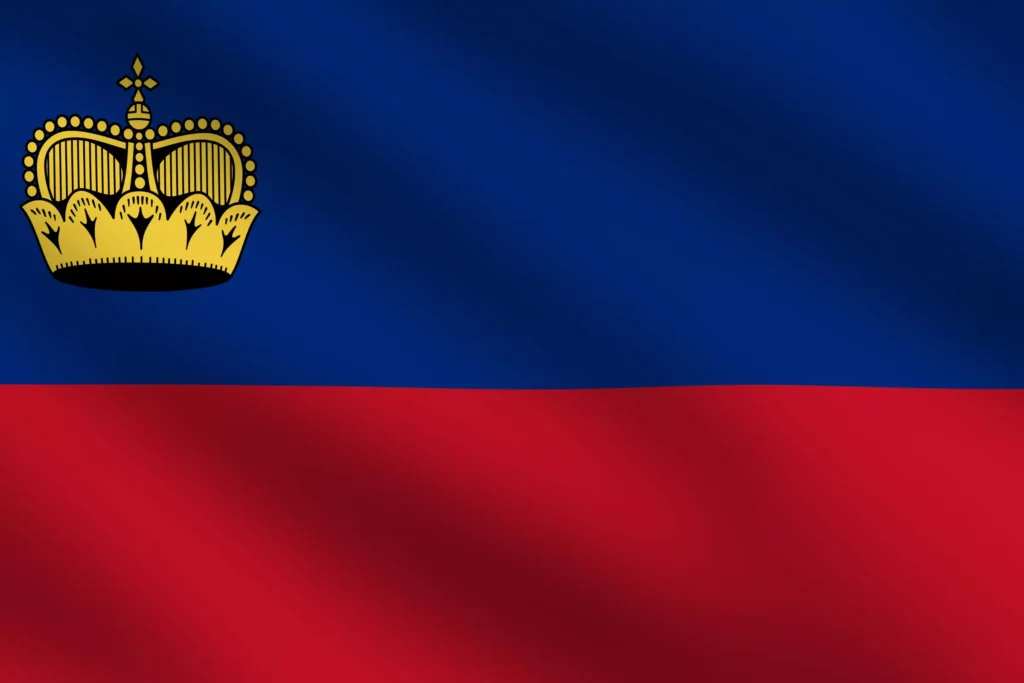Learn about the origins and symbolism of the Liechtenstein flag. Discover how the constitutional monarchy, with the Prince as head of state, has a highly industrialized, service-based economy. Understand the meaning behind the colors and design, independence, and Christian heritage. Get insight into Liechtenstein’s complex history and how the flag reflects its national identity.
General Information About Liechtenstein
Country Information
- Location: Central Europe
- Capital: Vaduz
- Population: around 38,000 people as of 2022
- Language: German
- Government: Constitutional monarchy
- Currency: Swiss Franc
- Economy: $184,083 (2021) GDP per capita
- Religion: Roman Catholic
Neighboring Countries of Liechtenstein
Table of Content
Flag History of Liechtenstein
Liechtenstein Kingdom during the Middle Ages
Color Of Liechtenstein Flag
Symbolism of the Flag of Liechtenstein
Frequently Asked Questions
Flag History of Liechtenstein
The flag of Liechtenstein was adopted in 1921 and consists of two equal horizontal bands of blue (top) and red with the national emblem on the upper hoist side. The colors are linked to the colors of the livery of the Princely House of Liechtenstein. Blue represents the sky, while red alludes to the evening fires that are lit inside the houses of Liechtenstein. The national emblem contains a gold crown representing the monarchy, above a red eagle with golden claws, beak, and tongue representing the medieval state of the Holy Roman Empire.
Liechtenstein Kingdom during the Middle Ages
Originally part of the Holy Roman Empire, Liechtenstein was a county. The Liechtenstein family acquired the region in 1434, and it was incorporated into the empire as a sovereign principality. Following their election to the Reichstag council in 1613, the Princes of Liechtenstein assumed a more significant position within the Holy Roman Empire. Liechtenstein attained complete sovereignty in 1806, following the dissolution of the Holy Roman Empire amid the Napoleonic Wars. Before regaining complete autonomy in 1945, it was absorbed into Nazi Germany during World War II and lost its independence for a brief period, from 1938 to 1945.
Color of Liechtenstein Flag

The national flag of Liechtenstein consists of two horizontal bands colored blue and red. The upper band is blue, representing the sky, while the lower band is red, representing the evening fires lit inside houses in Liechtenstein. Both blue and red have been the heraldic colors used by the Princes of Liechtenstein for centuries. The precise shades are defined as Pantone 287 for the blue and Pantone 186 for the red.
Symbolism of the Flag of Liechtenstein
The flag’s pattern and hues have geographical, political, and cultural significance. The red signifies the evening fires lighted in homes, while the blue represents the bright skies over the Alps. When combined, they depict Liechtenstein’s geographical location sandwiched between Austria and Switzerland. The constitutional monarchy is symbolized by the princely crown in the national emblem. The crimson eagle, which was removed from the Princes’ arms, symbolizes Liechtenstein’s lengthy history as a medieval member of the Holy Roman Empire. Overall, Liechtenstein has preserved peace and stability for generations, which is reflected in the straightforward style.
Frequently Asked Questions
Why is Liechtenstein so small?
- Liechtenstein is the sixth smallest country in the world, with an area of just 62 square miles. Its small size is partly due to its geography, located in the Alps between Switzerland and Austria. It has also initially just two small rural areas governed by the Liechtenstein princely family.
When did Liechtenstein become a country?
- Liechtenstein was established as a sovereign state within the Holy Roman Empire in 1719. It gained full sovereignty in 1806 after the dissolution of the Holy Roman Empire following the Napoleonic wars.
What language do they speak in Liechtenstein?
- German is the official language of Liechtenstein and is spoken by most of the population as a mother tongue. Alemannic German dialects are commonly spoken in everyday life.
What currency is used in Liechtenstein?
- Liechtenstein uses the Swiss franc as its official currency. It is in a customs and monetary union with Switzerland.
Is Liechtenstein part of Switzerland?
- No, Liechtenstein is an independent nation. However, it does have very close ties and an economic union with neighboring Switzerland.
Why is Liechtenstein so rich?
- Liechtenstein has a highly industrialized free-enterprise economy with low business taxes. Financial services, manufacturing, and precision instruments are major industries. It also has a prosperous economy and very high GDP per capita.
Is Liechtenstein part of the UN?
- Yes, Liechtenstein joined the United Nations in 1990 after the fall of the Soviet Union. It was previously unable to join as the USSR vetoed its application.
Does Liechtenstein have an army?
- No, Liechtenstein abolished its army in 1868 after its last military engagement in 1866. It maintains only a small police force for internal security. The country relies on Switzerland for its national defense.




